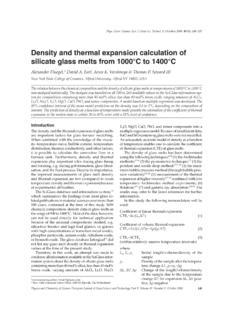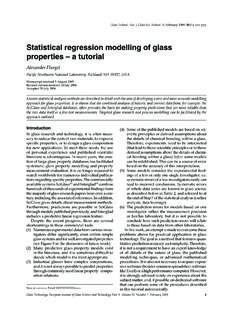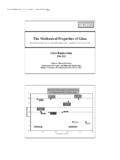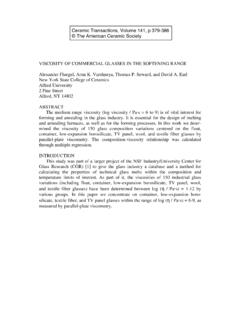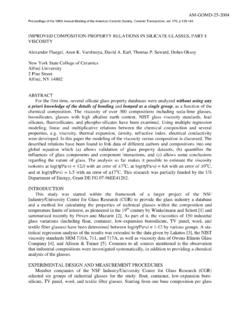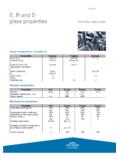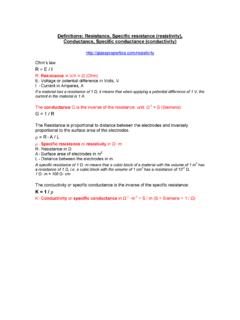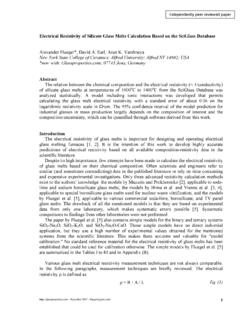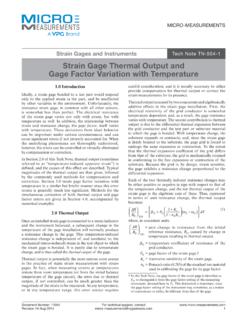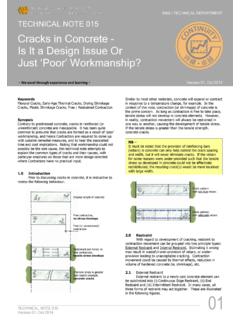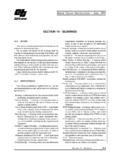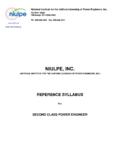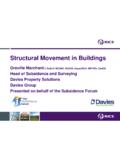Transcription of Independently peer reviewed paper - Glass Properties
1 - December 2007 - 1 - thermal expansion Calculation of Silicate Glasses at 210oC, Based on the Systematic Analysis of Global Databases Alexander Fluegel , 07743 Jena, Germany, Abstract: thermal expansion data for more than 5500 compositions of silicate glasses were analyzed statistically. These data were gathered from the scientific literature, summarized in SciGlass The analysis resulted in a data reduction from 5500 glasses to a core of 900, where the majority of the published values is located within commercial Glass composition ranges and obtained over the temperature range 20 to 500oC. A multiple regression model for the linear thermal expansivity at 210oC, including error formula and detailed application limits, was developed based on those 900 core data from over 100 publications.
2 The accuracy of the model predictions is improved about twice compared to previous work because systematic errors from certain laboratories were investigated and corrected. The standard model error was ppm/K, with R2 = The 95% confidence interval of predictions for Glass in mass production largely depends on the Glass composition of interest and the composition uncertainty. The model is valid for commercial silicate glasses containing Na2O, CaO, Al2O3, K2O, MgO, B2O3, Li2O, BaO, ZrO2, TiO2, ZnO, PbO, SrO, Fe2O3, CeO2, fining agents, and coloring and de-coloring components.
3 In addition, a special model for ultra-low expansion glasses in the system SiO2-TiO2 is presented. 1. Introduction The thermal expansion of glasses below the Glass transition range is important for Glass -to-metal bonding in the lighting industry, it plays a vital role for optimizing the time-temperature cooling schedule of glassware, and it enables the development of Glass sealing materials as well as the design of specialty Glass products that are exposed to varying temperatures. Numerous thermal expansion models exist in the scientific literature [1-15], summarized in a monograph by Scholze [16] and the SciGlass database [17], which enable the calculation of the thermal expansion of Glass below the transition range from the chemical composition.
4 However, the accuracy of the predictions is not yet satisfactory, mainly because of the limited number of model source data employed. For example, the standard deviation, , of the model residuals may be listed with the residuals being the differences between experimentally observed and calculated data. The values in ppm/K after deletion of outliers given by Priven and Mazurin [18] are (Appen [2]), (Gan Fu-Si [3]), (Novopashin and Seregin [5]), (Shchavelev [6]), (Takahashi [7]). The contemporary structural-chemical model by Priven has a standard deviation of the model residuals of ppm/K [1].
5 Selected models are listed in Table I. It is the objective of this work to substantially increase the model accuracy through statistical analysis of the SciGlass database. Independently peer reviewed paper - December 2007 - 2 - Table I: thermal expansion models by various authors (For calculation all weight fractions are multiplied by the coefficients below, and the products are summed to obtain in ppm/K.) Coefficients based on weight fraction of oxide (Appen based on mol fraction) Oxide Winkelmann and Schott [9] Appen [2] Lederova et al. [15] English and Turner [10] Hall [11] SiO2 0b B2O3 / P2O5 / / / Al2O3 Li2O 27 / / / Na2O (41)e K2O (49)e MgO CaO 13 SrO / 16 / / / BaO 20 Fe2O3 / / / ZnO / PbO / TiO2 / / / As2O3 / / / / ZrO2 / / / / Sb2O5 / / / SnO2 / / / Cr2O3 / / / / MnO / / / NiO / / / / CoO / / / Applicable temperature range in oC / 20-100 20-400 20-300 25-90 25-Tg a Coefficient for SiO2 = [SiO2] for [SiO2] 67 mol%.
6 Otherwise (expressions in brackets represent mol%) b SiO2 is excluded from the calculation in the model by Lederova et al. Instead, a constant of ppm/K is added. c Coefficient for SiO2 derived from figure = + [SiO2] [SiO2]2; [SiO2] 40 wt% d For glasses containing B2O3 the proportion F must be formed first, whereby the expressions in brackets represent mol%: F = {([Na2O]+[K2O]+[BaO])+ ([CaO]+[SrO]+[CdO]+[PbO])+ ([Li2O]+[MgO]+[ZnO]) [Al2O3]}/[B2O3] One then obtains: Coefficient for B2O3 = for F 4; otherwise e Values in parentheses are valid for binary glasses SiO2-R2O. The coefficient for K2O of applies only to those glasses that contain more than 1 mol% Na2O; otherwise, it is f The coefficients for Fe2O3 and MnO are valid for the normally occurring oxidation states.
7 G Coefficient for PbO = for glasses with [R2O] < 3 mol%, otherwise coefficient for PbO = + [R2O] h Coefficient for TiO2 = [SiO2] for 80 [SiO2] 50 Accurate model predictions are only possible based on accurate experimental data. In the following paragraphs, basic measurement principles will be described with the intention to - December 2007 - 3 - increase experimental accuracy. The thermal expansion is ascribed to the asymmetry of the amplitude of thermal vibrations in the Glass [19]. In turn, the asymmetric vibrations can be related to (a) the chemical bonding and composition, and (b) the temperature and fictive temperature ( thermal history).
8 The presence of more loosely bonded chemical units [20], an increased temperature [21, 22], and a fast cooling rate [21, 23] increase the thermal expansion . On the other hand, a more coherent network, a decreased temperature, and annealing lead to low- expansion glasses. Most investigators publish thermal expansion values in connection with the chemical composition of the investigated glasses and the temperature range for the expansion measurement. Generally, the thermal history is assumed to have an insignificant influence as long as well annealed samples are used. However, J. P. Joule was the first to report volume changes of Glass caused by expansion effects over 45 years, later connected to the "zero point depression" in precision thermometers [24, 25].
9 This effect is related to long-term arrangements of mobile alkali ions in glasses that are not sufficiently annealed, and it de-creases the thermal expansion . O. Schott found up to 5% expansion differences between fine annealed and chilled bulk Glass [26]. Hence, in this work, only annealed glasses were considered, and the thermal history was neglected. In addition, it needs to be mentioned that glasses in specific composition ranges tend to phase-separation [27] and crystallization [28]. Because those effects can result in sudden composition-expansivity changes, only homogeneous glasses were included in this study.
10 The findings of Stozharov and Bogatyreva [29] about expansion "jumps" in glasses were regarded as incorrect for homogeneous and well annealed glasses or categorized as a crystallization effect. In this study, the following nomenclature will be used: Coefficient of linear thermal expansion , TLLCTEo = (1) Expansivity, dTLdLo = (2) where Lo is the initial length of the sample at room temperature, L is the change of the length of the sample caused by the temperature change T (for expansion , L = positive), and dL is the infinitesimal change of the length of the sample resulting from the infinitesimal temperature change dT (dL = L for T 0).
